by Eric Meier
When attempting to identify a wood sample, it’s important to keep in mind the limitations and obstacles that are present in our task. Before starting, please have a look at The Truth Behind Wood Identification to approach the task in a proper mindset; I consider the linked article to be required reading for all those visiting my site with the intent of identifying wood.
1. Confirm it is actually solid wood.
Before proceeding too much farther into the remaining steps, it’s first necessary to confirm that the material in question is actually a solid piece of wood, and not a man-made composite or piece of plastic made to imitate wood.
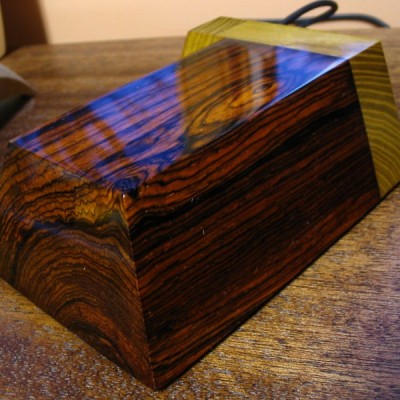
Can you see the end-grain?
Manufactured wood such as MDF, OSB, and particleboard all have a distinct look that is—in nearly all cases—easily distinguishable from the endgrain of real wood. Look for growth rings—formed by the yearly growth of a tree—which will be a dead-giveaway that the wood sample in question is a solid, genuine chunk of wood taken from a tree.
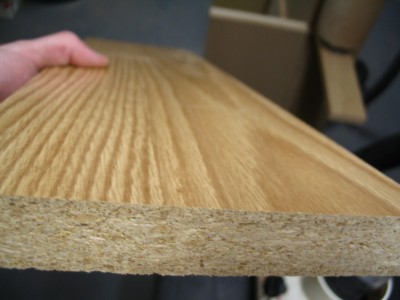
Is it veneered?
If you see a large panel that has a repeating grain pattern, it may be a veneer. In such cases, a very thin layer of real wood is peeled from a tree and attached to a substrate; sometimes the veneer can be one continuous repeating piece because it is rotary-sliced to shave off the veneer layer as the tree trunk is spun by machines. Assuming it is a real wood veneer with a distinct grain and texture—and not merely a piece of printed plastic—you may still be able to identify the outer veneer wood in question, but you should still realize that is it only a veneer and not a solid piece of wood.
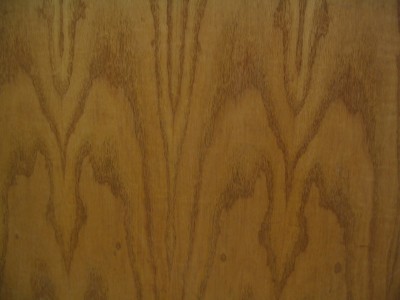
Is it painted or printed to look like wood?
Many times, especially on medium to large-sized flat panels for furniture, a piece of particleboard or MDF is either laminated with a piece of wood-colored plastic, or simply painted to look like wood grain. Many of today’s interior hardwood flooring planks are good examples of these pseudo-wood products: they are essentially a man-made material made of sawdust, glues, resins, and durable plastics.
2. Look at the color.
Some questions to immediately ask yourself:
Is the color of the wood natural, or is it stained?
If there is even a chance that the color isn’t natural, the odds are increased that the entire effort of identifying the wood will be in vain.
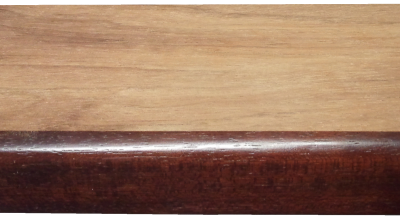
Is it weathered or have a patina?
Many woods, when left outside in the elements, tend to turn a bland gray color. Also, even interior wood also takes on a patina as it ages: some woods get darker, or redder, and some even get lighter or lose their color; but for the most part, wood tends to darken with age.
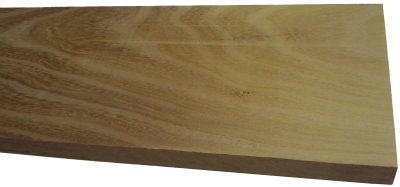
Is it possible to sand or plane the board to see the natural raw color of the wood?
The most predictable baseline to use when identifying wood is in a freshly sanded state. This eliminates the chances of a stain or natural aging skewing the color diagnosis of the wood.
3. Observe the wood grain.
If the wood is unfinished, then look at the texture of the grain. Ask yourself these questions:
Does the wood have an open, porous texture?
Most softwoods will be almost perfectly smooth with no grain indentations, while many common hardwoods have an open pore structure, such as oak or mahogany; though there are some hardwoods that are also smooth to the touch, such as maple.
Can you tell if the wood is quartersawn or plainsawn?
By observing the grain patterns, many times you can tell how the board was cut from the tree. Some wood species have dramatically different grain patterns from plainsawn to quartersawn surfaces. For instance, on their quartersawn surfaces, lacewood has large lace patterns, oak has flecks, and maple has the characteristic “butcher block” appearance.
Is there any figure or unusual characteristics, such as sapwood, curly or wild grain, burl/knots, etc.?
Some species of wood have figure that is much more common than in other species: for example, curly figure is fairly common in soft maple, and the curls are usually well-pronounced and close together. Yet when birch or cherry has a curly grain, it is more often much less pronounced, and the curls are spaced farther apart.
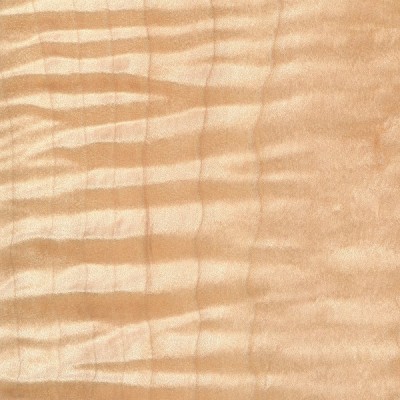
4. Consider the weight and hardness of the wood.
If it’s possible, pick the piece of wood up and get a sense of its weight, and compare it to other known wood species. Try gouging the edge with your fingernail to get a sense of its hardness. If you have a scale, you can take measurements of the length, width, and thickness of the wood, and combine them to find the density of the wood. This can be helpful to compare to other density readings found in the database. When examining the wood in question, compare it to other known wood species, and ask yourself these questions:
Is the wood dry?
Wood from freshly felled trees, or wood that has been stored in an extremely humid environment will have very high moisture contents. In some freshly sawn pieces, moisture could account for over half of the wood’s total weight! Likewise, wood that has been stored in extremely dry conditions of less than 25% relative humidity will most likely feel lighter than average.
How does the wood’s weight compare to other species?
Taking into account the size of the board, how does its weight compare to other benchmark woods? Is it heavier than oak? Is it lighter than pine? Look at the weight numbers for a few wood species that are close to yours, and get a ballpark estimate of its weight.
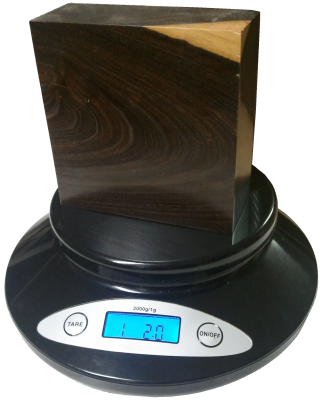
How hard is the wood?
Obviously softwoods will tend to be softer than hardwoods, but try to get a sense of how it compares to other known woods. Density and hardness are closely related, so if the wood is heavy, it will most likely be hard too. If the wood is a part of a finished item that you can’t adequately weigh, you might be able to test the hardness by gouging it in an inconspicuous area. Also, if it is used in a piece of furniture, such as a tabletop, a general idea of its hardness can be assessed by the number and depth of the gouges/dings in the piece given its age and use. A tabletop made of pine will have much deeper dents than a tabletop made of Oak. Additionally, you can always try the “fingernail test” as a rough hardness indicator: find a crisp edge of the wood, and with your fingernail try to push in as hard as you can and see if you’re able to make a dent in the wood.
5. Consider its history.
Many times we forget common sense and logic when attempting to identify wood. If you’ve got a piece of Amish furniture from Pennsylvania, chances are more likely that the wood will be made of something like black walnut or cherry, and not African wenge or jatoba. You might call it “wood profiling,” but sometimes it can pay to be a little prejudiced when it comes to wood identification. Some common-sense questions to ask yourself when trying to identify a piece of wood:
Where did it come from?
Knowing as much as you can about the source of the wood—even the smallest details—can be helpful. If the wood came from a wood pile or a lumber mill where all the pieces were from trees processed locally, then the potential species are immediately limited. If the wood came from a builder of antique furniture, or a boat-builder, or a trim carpenter: each of these occupations will tend to use certain species of woods much more often than others, making a logical guess much simpler.
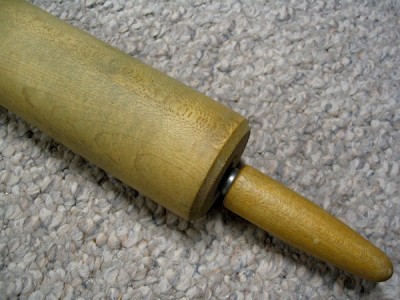
How old is it?
As with the wood’s source, its age will also help in identification purposes. Not only will it help to determine if the wood should have developed a natural patina, but it will also suggest certain species which were more prevalent at different times in history. For instance, many acoustic guitars made before the 1990s have featured Brazilian rosewood backs/sides, yet due to CITES restrictions placed upon that species, East Indian rosewood became a much more common species on newer guitars. (And this is a continuing shift as newer replacements are sought for rosewoods altogether.)
How large is the piece of wood?
Some species of trees are typically very small—some are even considered shrubs—while others get quite large. For instance, if you see a large panel or section of wood that’s entirely black, chances are it’s either painted, dyed, or stained: Gaboon ebony and related species are typically very small and very expensive.
What is the wood’s intended use?
Simply knowing what the wood was intended for—when considered in conjunction with where it came from and how old it is—can give you many clues to help identify it. In some applications, certain wood species are used much more frequently than others, so that you can make an educated guess as to the species of the wood based upon the application where it was used. For instance, in the United States: many older houses with solid hardwood floors have commonly used either red oak or hard maple; many antique furniture pieces have featured quartersawn white oak; many violins have spruce tops; many closet items used aromatic red cedar, and so forth. While it’s not a 100% guarantee, “profiling” the wood in question will help reduce the number of possible suspects, and aid in deducing the correct species.
6. Find the X-Factor.
Sometimes, after all the normal characteristics of a sample have been considered, the identity of the wood in question is still not apparent. In these instances—particularly in situations where a sample has been narrowed down to only a few possible remaining choices—it’s sometimes helpful to bring in specialized tests and other narrower means of identification.
The following techniques and recommendations don’t necessarily have a wide application in initially sorting out wood species and eliminating large swaths of wood species, but will most likely be of use only as a final step in special identification circumstances.
Odor
Believe it or not, freshly machined wood can have a very identifiable scent. When your eyes and hands can’t quite get a definitive answer, sometimes your nose can. Assuming there is no stain, finish, or preservative on or in the wood, quickly sand, saw, or otherwise machine a section of the wood in question, and take a whiff of the aroma.
Although new scents can be very difficult to express in words, many times the scent of an unknown wood may be similar to other known scents. For instance, rosewoods (Dalbergia spp.) are so named for their characteristic odor that is reminiscent of roses. Although difficult to directly communicate, with enough firsthand experience scents can become a memorable and powerful means of wood identification.
Fluorescence
While certain woods can appear basically identical to one another under normal lighting conditions, when exposed to certain wavelengths—such as those found in blacklights—the wood will absorb and emit light in a different (visible) wavelength. This phenomenon is known as fluorescence, and certain woods can be distinguished by the presence or absence of their fluorescent qualities. See the article Fluorescence: A Secret Weapon in Wood Identification for more information.
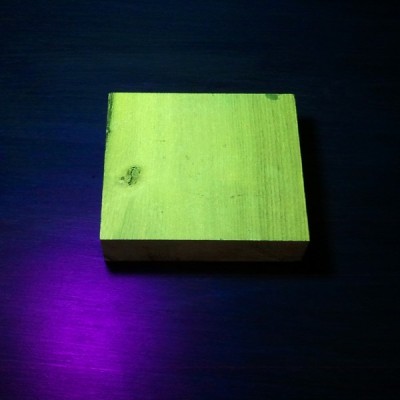
Chemical Testing
There are only a small number of chemical tests regularly used on wood, most of which are very specialized and were developed to help distinguish easily confused species with one another. They work by detecting differences in the composition of heartwood extractives. A chemical substance (called a reagent) is usually dissolved in water and applied to the wood surface: the surface is then observed for any type of chemical reaction (and accompanying color change) that may occur. Two of the most useful are the tests that are meant to separate Red and White Oak, and Red and Hard Maple.
Heartwood Extractives Leachability
Sometimes a wood species will have heartwood extractives that will be readily leachable in water and capable of conspicuously tinting a solution of water a specific color. For instance, the heartwood extractives contained in osage orange (Maclura pomifera) contain a yellowish-brown dye that is soluble in water. (This can sometimes be observed anecdotally when the wood is glued with a water-based adhesive: the glue’s squeeze-out is an unusually vibrant yellow.)
In a simple water extract color test, wood shavings are mixed with water in a vial, test tube, or other suitably small container, and the color of the water is observed after a few minutes. If the heartwood extractives are leachable by water, then a corresponding color change should quickly occur.
In addition to osage orange (Maclura pomifera), merbau (Intsia spp.), and rengas (Gluta spp. and Melanorrhoea spp.) are also noted for their readily leachable heartwood extractives. Because this property is quite uncommon, it can serve to quickly differentiate these woods from other lookalikes.
7. Look at the endgrain.
Perhaps no other technique for accurate identification of wood is as helpful and conclusive as the magnified examination of the endgrain. Frequently, it brings the identification process from a mostly intuitive, unscientific process into a predictable, repeatable, and reliable procedure.
Looking at the endgrain with a magnifier shouldn’t be a mystifying or esoteric art. In many cases, it’s nearly as simple as examining small newsprint under a magnifying glass. There are three components necessary to reap the full benefits contained in the endgrain:
I. A prepared surface.
When working with wood in most capacities, it becomes quickly apparent that endgrain surfaces are not nearly as cooperative or as easily worked as face grain surfaces. However, in this case, it is absolutely critical that a clear and refined endgrain surface is obtained.
For a quick glance of a softwood sample, a very sharp knife or razor blade can be used to take a fresh slice from the endgrain. However, in many denser species, especially in tropical hardwoods, one of the best ways to obtain a clear endgrain view is through diligent sanding. It’s usually best to begin with a relatively smooth saw cut (as from a fine-toothed miter saw blade) and proceed through the grits, starting at around 100, and working up to at least 220 or 320 grit, preferably higher for the cleanest view.
II. The right magnifier.
It need not be expensive, but whatever tool is used to view the endgrain should have adequate magnifying power. In most instances, 10x magnification is ideal, however, anything within the range of 8 to 15x magnification should be suitable for endgrain viewing. (Standard magnifying glasses are typically in the range of 2 to 4x magnification.)
These stronger magnifiers, sometimes called loupes, usually have a smaller viewing area than standard magnifying glasses. Fancier models—with built in lights, or larger viewing surfaces—are available at a premium; but the most basic models are usually only a few dollars.
III. A trained eye.
The third element that constitutes a proper endgrain examination is simply knowing what to look for. In analyzing the patterns, colors, shapes, and spacing of the various anatomical features, there is a veritable storehouse of information within the endgrain—all waiting to be unlocked. Yet, if these elements have not been pointed out and learned, the array of features will simply seem like an unintelligible jumble. The discipline of recognizing anatomical endgrain features is not easily summed up in a few sentences or even a few paragraphs, but it is nonetheless critical to the identification process. To this end, an in-depth look should be given to the various categories, divisions, and elements that constitute endgrain wood identification on the macroscopic level. (In this regard, macroscopic denotes what can be seen with a low-powered, 10x hand lens—without the aid of a microscope—rather than simply what can be seen with the naked eye.) Because the anatomy between softwoods and hardwoods is so divergent, each will be considered and examined separately:Still stumped?
If you have a mysterious piece of wood that you’d like identified, you’ve got a few options for next steps:USDA’s Forest Products Laboratory
You can mail your physical wood samples to the Center for Wood Anatomy Research.
Pros:
- Free
- Professional wood identification
Cons:
- Only available to US citizens
- Slow turnaround times (up to a month or more)
- Limited to three IDs per year
See their Wood ID Factsheet for more info.
Alden Identification Service
You can mail your physical wood samples (even small sections taken from antiques) to Alden Identification Service.
Pros:
- Professional wood identification
- Faster turnaround times (ranging from a few days to a week or two)
Cons:
- Paid service
See their ordering page for more info. (Note that Harry Alden has written several books while at USDA, including both Hardwoods and Softwoods of North America.)
Ask for help online
If the wood ID is merely a curiosity, or non-critical, you can post pictures of the wood in question.
Pros:
- Free
- No need to send physical samples
Cons:
- Greatly limited by the quality of the pictures provided
- Extra work usually required to get adequate clarity in photos
See article of Common US Hardwoods to help find the most commonly used woods.
Get the hard copy
 If you’re interested in getting all that makes The Wood Database unique distilled into a single, real-world resource, there’s the book that’s based on the website—the Amazon.com best-seller, WOOD! Identifying and Using Hundreds of Woods Worldwide. It contains many of the most popular articles found on this website, as well as hundreds of wood profiles—laid out with the same clarity and convenience of the website—packaged in a shop-friendly hardcover book.
If you’re interested in getting all that makes The Wood Database unique distilled into a single, real-world resource, there’s the book that’s based on the website—the Amazon.com best-seller, WOOD! Identifying and Using Hundreds of Woods Worldwide. It contains many of the most popular articles found on this website, as well as hundreds of wood profiles—laid out with the same clarity and convenience of the website—packaged in a shop-friendly hardcover book. 





Why I will no longer be replying to every wood ID request I’ve replied to literally thousands of wood ID requests on this site over the past 13+ years, but as the site’s popularity has grown, so has the time demands for ID on a daily basis. (Contrary to what some may seem to think, I am not some all-knowing wood wizard that can instantly ID your wood. It can actually take me a long time to sift through a lot of different resources.) Over the past few years, my backlog of pending wood species to be added to the… Read more »
I just added your book to my wishlist. I have some reclaimed material from a home built in the 40’s in the northwest. The flat stock looks like vg fir as do the moldings, with the exception that they are both brown all the way through, not just on the surface due to UV exposure. when cut it has that familiar smell of old full dimensional lumber. Looks like fir. Smells like fir. But it’s brown, like a brown cedar. Is old growth fir brown? The material was milled 80 years ago so the tree is a few hundred years… Read more »
Hard to say what exactly is meant by “brown” without pictures. Also, there’s a difference between true “fir” which stays a fairly light color, and “Douglas fir” which may turn a slightly orangish brown over time.
Here’s a picture of the molding. If freshly cut it looks the same.
Looks like a softwood. Possibly Douglas fir.
This will seem far fetched based on what I’ve said so far, but I’m starting to think this is old growth vertical grain western red cedar. It’s harder than I would expect and it has only the slightest aroma when cut that doesn’t resemble cedar at all, but having never worked with 80 year old cedar it took me a while to come to this conclusion. I’ve been a carpenter for 35 years and I worked in a specialty plywood mill for 4 years as a young man. We actually made cedar plywood and that smell is etched in my… Read more »
Western red cedar odor is pretty unmistakable, and different than douglas fir, so if you are familiar with both scents, that could be a good indicator. Also softness and weight would be quite different.
I’m familiar with the odor of both, but this material has essentially no odor. I thought I got a hint of something initially when I cut it that smelled like old full dimensional lumber, which doesn’t smell anything like modern framing material, but I’m not getting that now and no one else is either. In fact no one smells anything. The color reminded me of cedar, but the grain looked like VG fir, so I headed down that path, but I think this is what a 200 year old tree looked like when milled 80 years ago. The grain is… Read more »
Hello. Any suggestions as to this wood type? I am refinishing a desk for my daughter. This has been sanded.
Looks like some nice black cherry to me, a nice hardwood. Not sure if the two pics are a before and after sanding, but if that second is the sanded piece, I’d recommend to keep going to a higher grit. I can still see the tiny orbital sanding scratches on the face grain!
Thank you. This was the sanding after 80 grit. I continued to 220 for a nice smooth finish.
Hey Eric, found these in a 1930’s kitchen. Wood is sanded and unstained. No knots, scratches with a fingernail. Any guesses?
Yes, looks like an old growth softwood. Pretty light colored though, so probably not the typical hard pine, perhaps something like fir or hemlock? Or a soft pine.
Thanks Eric!
Hello Eric, thank you for the awesome post. I purchased a house last year that has lots of wood paneling. It might be real wood? Do you believe this is normal knotty pine? Thank you so much!
Yes, real wood, but not pine. It looks to be a ring porous (or semi-ring-porous) hardwood of some sort. I can’t tell the species for sure, but it looks like some decent wood. What region are you located in? Is this in the US?
The house was built in ‘57 and am from the Northern Illinois area. I really love the house and it has so many other types of wood also. Thank you again!
I’m working on some tables from my husband’s late uncle. I am under the impression they are from the 70s-80s. Just this small end table weighs 75lbs alone. I am just curious what they are made of and hope you can help. First photo is not sanded. The second one is. I can take a better picture if you need one.
Looks like softwood of some sort, possibly douglas fir.
All I can say for sure is that it is a ring porous hardwood that’s been stained a dark walnut color. Ash is a ring porous hardwood, so I’d be pretty confident that that’s what it is.
Dear Eric, thank you for this article! I have a (very big) closet that came with the house. I want to renovate it, maybe paint it, but I don’t know what it’s made from. I don’t think it’s wood. I would really appreciate your diagnose. Thank you very much.
Looks like solid beech. A good, durable cabinet hardwood. But also decent for painting too as the pores are small enough to not create unevenness in the finish coats.
Wow thank you so much!! I was sure it’s not a real wood. Should I paint it with oil based paint or a latex paint can work as well? Thank you very much
If it were me, I’d lightly scuff sand the surface with something like 220 grit sandpaper and then use primer for first coat, then follow up with latex paint for simplicity + easier clean up. You may have adhesion issues if you don’t properly prepare the surface first.
What type of wood is this? Would it be good for making an out door sign?
I can’t ID the wood. Generally the lighter colored portions on the edge (called sapwood) is not good for exterior applications and is rot prone. I can even see a bug hole in that sapwood in the picture.
what type of wood is this? i bought this at an antique shop and was curious.
A burl veneer, a nice find. Possibly elm burl, but very hard to ID burl veneer.
thank you!
Dear Eric,
I bought this trestle dining table from my friend when she moved back to Ireland. This farmhouse table was shipped from her moms estate in Ireland. I would like to know what type of wood it is.
I can’t manage to attach photos, so here is link to them in Google Photos: https://photos.app.goo.gl/GVKGNe3iF52HEgZ48
I can’t tell, sorry. Face grain does have a superficial resemblance to mahogany.
Thank you!
Hi Eric, thanks for the very helpful article! I just paint-stripped an old hope chest today and this is what was uncovered. Could you tell me what kind of wood it is? Many thanks!
Hard to say for sure, but it looks like walnut. Would be a nice find if it is indeed walnut.
I thought it was a veneer but top appears to be solid wood.
Hard to tell with that dark stain obscuring everything. There may be a thicker ~1/8″ thick veneer that was attached to the drawer front.
I can’t attach photos…. here is a link to photos: https://photos.app.goo.gl/1QeBHUdUaztva6437
One is bare wood that was under the top.
That trim is veneered. The endgrain is so rough I can’t tell if the pattern is rays, growth rings, or just saw marks. The pattern of the first pic does resemble mahogany though.
Any idea what this table is made of Thanks
Are these three different pieces, or why do each of the pictures look so drastically different?
The top of the table is very bright orangey, rich and the last one is underneat the table. I have sent another
My tablet is not so good how about this one. It was a cheap table from eBay but I am wanting to match the wood
Looks like a ring porous hardwood. I would probably use ash with a matching stain.
Thank you
Can anyone say what kind of wood it is? It’s from an old furniture in Belgium, so very likely an European species.
It does look like beech but the color puts me off – while all the beech I have seen is white – yellow – pink this one is much more browner.
Any idea?
I can see where you’d think it’s beech with the rays. But it’s a ring porous hardwood, whereas beech is diffuse porous. To me, it most looks like a species in the red oak grouping based on its color and ray length. Not sure what species of oak might be used in Belgium though. https://www.wood-database.com/wood-articles/distinguishing-red-oak-from-white-oak/
Thanks for the info. You are right, probably it’s some sort of red oak which I read is quite spread in Europe although not native.
Has quite the fragrance!
Probably a type of cedar. What region are you (and the tree) located?
Southeast Florida. It’s quite heavy and not as soft as the common red cedar. However, the knots look very familiar with regards to cedar. Thanks for replying.
Planed this down and revealed this
Hello! I followed your guide from start to finish, and last i sand it to get the original colour from its grey. But still have no clue. I’m in brazil northeast and this is a door meant to go outside. Do you have an idea what it may be? I’m a woodworker wannabe and intend to make it into a table. If i don’t find out what wood it is i’ll just buy some massaranduba to make the table feet.
Can’t tell from picture, sorry
I have researched a LOT in the internet and now I am very inclined to believe it is Acapu, a tree found in one state of north Brazil and in Guyanas. Doesn’t absorb humidity and it is very heavy and dense! It’s great
Thanks for all the info! I just bought an old home and can not figure out what the different hardwoods are throughout the house. Any ideas?
The first two look like stained oak floor boards. The last one appears to be old growth yellow pine.
Dear Eric,
What type of wood do you think this might be? We plan on building a fire place mantle and would like them to look like they belong together. Do you think you could suggest types of wood and stains and laquers or wax and things of that nature? We do not work with wood so much, so talk slowly ;)
In Christ,
Kimberly Gill
I can’t tell the wood species from the picture, but the color is a dark walnut. You could probably match the color using a dark walnut type stain. Otherwise, if you wanted to forgo stain and use natural wood finish you could just use black walnut wood (more expensive).
Would anyone know what wood this table and chairs are made our of? thanks
Anyone able to identify this wood? I sanded down an old dresser and am having a difficult time determining from comparing to online pics! Thx!
Those ray flecks look like oak to me.
What types of wood are on the floor and stairs/banister
Can’t say for sure from that distance, but the floor could be birch. Banister is a softwood, possibly douglas fir or pine.
I saw some descriptions as gumwood but idk
Where are you located?
Anyone recognize this wood? It’s flooring in the upstairs of circa 1899 commercial building in Middle Tennessee. I’ve been sanding on it, and the sawdust is distinctly red.
Looks like southern yellow pine
Wouldn’t there normally be knots in pine flooring?
Not necessarily, or at least not as many as you’d see today, especially if the wood was taken from very old (and very large) trees. It’s sometimes called heart pine or antique pine.
Thanks for the info. I noticed when sanding on it that the dust has a very distinct smell that seems familiar. Since I grew up in FL where there was nothing but pine trees, that could explain it. I’m sure the wood came from old growth trees so no knots would make sense.
Wow, great article! I’m trying to figure out what type of wood this table is made out of. It is solid wood for sure, it weighs literally 100lbs, but I can’t tell because it is stained.
The stain is meant to look like cherry, but it’s hard to tell just what the wood is. Possibly maple. Would need a closer image of wood grain for better chance at ID.
Trying to determine the wood. Thinking maple? Table is circe 1920. Unfinished..and small clear coated section.
If that clear coat section is really the natural color and not a stain, I’d say it’s probably black walnut.
Inherited this 20ish y.o. dining table and chairs. Solid wood, any ideas on what kind? Chair has recently been sanded, tabletop has not.
Looks like rubberwood, also known as plantation hardwood. https://www.wood-database.com/rubberwood/
Hi Eric,
Thank you for the comprehensive article.
Can you help me identify what kind of wood is this old kitchen cupboard door is made of please?
It broke recently and has been fixed with glue and plates, but a crack is still slightly visible so I am trying to see if I could use some wood filler to fill the gap.
For purposes of color matching, it most resembles cherry. (Though it may not actually be made of cherry…)
What is this banister built in 1965 made of?
I believe it’s made of different species, both stained to look like cherry. The turned post appears to be a softwood such as pine. For the actual railing itself is hard to tell for sure. I can just make out a little bit of ray fleck on the first picture on the far right side, and the fleck patterns look most like beech to me.
What type of wood is this? I feel it’s a veneer but I’m not too sure… need to sell it and I want to be accurate with my description. Thank you in advance!
I would agree that it is veneered top. The overall color and grain is definitely meant to resemble black walnut. However, I’m not entirely convinced from the pictures that it’s actually walnut. I can’t actually make out any visible pores as walnut would have. It may be something like figured maple veneer with a dark walnut stain. I would need to see a close up of the growth rings to see more.
Hello I am a painting contractor remodeling a 100 year old home. We have 200 year old door we are working on and need help identifying what type of wood this is, can you help
?Need to post pictures.
Any idea on wood type in this cutting board?
More than likely its hard maple
What type of wood is this
Will need a better picture to have a chance at ID. Can you get closer to the wood grain?
What is the ceiling and the bannister rails made out of? And the big beam?
Ceiling is a softwood of some sort, possibly fir or pine. Can’t tell on the others. Rails appear to be stained and not natural color, possibly a softwood as well. What country is this located in?
House built in 1975 and in Minneapolis Minnesota. The short pieces are part of my railing and I am trying to buy 2 x 2 so the railing will be up to code. They are stained a dark color. I tried to stain some pine and it does not look like a match to the grain at all. They have a lot of knots too.
My brother is cutting some wood not sure what kind
The 3 planks are lying on an ash tree. These are not from that tree. You can see the bark of the tree In The other photo where they are lying on the ground. This is in southwest Nebraska
My brother is cutting some trees not sure what type though. Southwest Nebraska
Hi, could someone please help me identify what type of wood this is?
you need to attach pics
Hello! Can you help me identify my wood floor? I’m hoping to stain it but don’t know what type of wood it is.
Hmm, it looks similar to beech to me. Maybe another close shot that’s more top-down might help settle it. Are you planning to re-sand the floors first and then apply stain? Keep in mind that if is is beech, it is a diffuse porous wood so it will stain differently than the stain samples shown in a lot of stores, where they use oak (a ring-porous hardwood) to demonstrate the color.
Also trying to identify this wood. I was told what was it but I forgot. Thank you.
Nobody knows what this is?
Can you clean up / sand the endgrain and get a closer shot of the endgrain? Also, where are you located, or where did the wood come from? How heavy is it in comparison to other woods? Any noticeable scent?
I was told it is walnut? Im in Virginia. Is heavy and probably harder than the oak. Light smell. Thank you.
These two pictures are before/after of the same piece? The first piece’s endgrain definitely does not match black walnut as it appears to be purely diffuse porous. Are you familiar with the smell of black walnut? If it smells like walnut, then it’s probably a tropical walnut, sometimes called Peruvian walnut or nogal. https://www.wood-database.com/peruvian-walnut/
The rectangular piece is 1.5” x 1.5” 3.5” and weights 75g. It was locally cut and I’m almost positive he said walnut. The processed piece (the pipe) has a coat of cutting board oil. If it is local to VA, what else can it be?
That weight works out to only 690kg/m3, which is pretty close to regular walnut. I bet it’s just black walnut. I’ve seen examples where the endgrain is diffuse porous, very much resembling tropical walnut. I think this can sometime happen in abnormal growing conditions, possibly slower growing conditions.
Thank you.
Hi! Does anyone know what type of wood this is?
To me, it just looks like pine or another softwood, using varying shades of stain for contrast.
Oh right! I thought it was likely to be a hard wood – possibly mahogany based on the tight grain and its smooth feel. I’ve attached another picture showing the grain more clearly just in case :)
Those pics are a little more helpful. It looks like the darker wood for the top and drawer fronts is a cherry veneer, while the lighter colored wood for the frame is mahogany. At least that’s my best guess based on pics.
Hello! Can anyone identify what type of wood this is please? Thank you
Looks like oak to me.
Could someone please help me identify this wood. Very hard, dense and heavy. Hard to cut and has a distinctive smell when cut, though the smell does not last long. Don’t know how to describe the smell.
Most likely guess is a figured piece of sapele.
I found this block of wood at a local wood craft shop and the people that work there couldnt identify it. They said they cut it in half to see if it was stained and its the same all the way through. I have more picures of different angles if you need them.
Please post a picture of the endgrain
The glue is where they cut it and glued it back together
Looks like a man-made/engineered product. I don’t see any traces of wood grain or other anatomical elements found in normal wood. Probably made of dyed wood arranged in alternating color strips and glued together under pressure.
Can you identify this wood? Heavy, feels solid but hard to tell, purchased from an Interior Designer in 2001. Just noticed a “China” stamp on the bottom. I’ve never liked the red hued stain and have decided to refinish. This is after stripping before sanding.
That top pattern is really only possible with veneer, so not solid. It is a burl veneer, but it’s hard to tell just what it is exactly. If I had to guess based solely on your location, I’d say camphor burl, but it really could be a number of different possibilities.
Can somebody help me identify this wood. A friend gave me some scraps to make pipes and I’m having a hard tome (lack of knowledge). Thank you.
That looks like a piece of yellow pine to me. https://www.wood-database.com/wood-articles/pine-wood-an-overall-guide/
It looks more pinkish than the picture and is dense and heavy but my nail will sink half a mil in the light color part with some effort. Is that consistent with yellow pine? Thank you.
Well, its defienitely a softwood of some sort. You should check the endgrain closer for resin canals, which would help to confirm pine. There’s a lot of kinds of pine, so this is considered a “hard pine.”
Thank you.
Can anyone identify this wood flooring? I’m in MI, home is approx 150 years old. It has been sanded bare.
That’s oak. Looks like red oak to me.
Hoping you can help. I am trying to clean up an art deco waterfall dresser . i know it is veneer and i know there are solid woods, but I don’t know if it all walnut or if there is a mahogany in there as well as the zebra wood. I am going to make some adaptions to repair the bigger pieces of veneer and want to get it right.
Yes, it looks like the primary wood used for the front was mahogany veneer. I think the biggest thing would be trying to match stain color and grain pattern of individual pieces.
Thanks. I was thinking it was walnut .. and, some of the drawers are VERY dark and I cannot imagine them being mahogany, but with the art deco waterfall … you never know. I used Boiled linseed oil on the top .. just to feed the wood. We will see what happens with the rest. Thanks, again.
Help from the U.K.!!! These beams are from a barn roof structure (untreated timbers are the purlins) the king post is stained with a light oak wood dye which has worked fine but darkened the purlins considerably so I believe they’re different types of timber. I think the roof construction is about 100 years old. Grateful if anyone can identify the timber in the picture of one of the untreated purlins???? TIA
Please help, I’m trying to make extra leafs for this beautiful Eastlake table I’m bringing back to life and have no idea what the top already is.
Need to get a better, closer picture of the wood grain.
Oh, please, please, please, help me identify this wood-definitely solid.. no veneers for sure.. It was a 4-5ft wide gentleman’s chest, almost 5ft tall. I’m broken-hearted. It was stolen from me and I need to quantify the damages.
That’s pretty difficult to tell from the picture. Do you have an idea of its age and where it came from? What country/region are you located in?
I bought this table in North Carolina in 2006. The wood is soft- gouges and scratches fairly easily. Any ideas what it might be?
It’s hard to tell from the picture. It’s possible that it could be walnut veneer. The color matches, but not the grain in all respects, though the center strips look closer to walnut grain than the outer border veneer.
Thank you got the reply, Eric. Here’s another angle. I contacted Furnitureland South where I purchased it in 2006 but they didn’t have record. A designer there tried to help and looked at this photo and thought burlwood? Doesn’t look like any burL wood I’ve seen?
No, it’s not a burl wood, though it does look like it’s a veneered top by all of the patterns seen. Superficially, the color resembles black walnut at some angles. I would need to see a much closer picture of the grain in order to get a better idea of wood ID though.
It’s also quite heavy
Weight will not be an issue for ID here as that would only reflect the substrate underneath that the veneer is attached to.